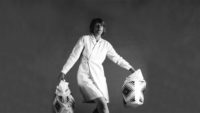You have no items in your cart. Want to get some nice things?
Go shoppingMany years ago I went to a performance by the artist Bobby Baker. I’d never seen her work before. She arrived on stage wearing an electric blue suit and heels and pushing a cardboard box. Her show was different to anything I’d come across before. More than a decade later, though I remember very little about the rest of the performance, I still recall with absolute clarity the startling sight of a blonde woman in a bright blue suit pushing a box onto the stage. Only days before Baker’s show I’d moved back to London after living for two years in Manchester. My own life was still in packing crates. A couple of days after the show and still surrounded by unopened boxes, I cleared a space, sat down and wrote a story. The content of the story itself bore no relation to Baker’s material but it contained a scene in which a woman in a blue suit pushed a box across open ground. The arrival of this figure in my story was unexpected and I remember how surprised I was by it given that I hadn’t particularly connected with Baker’s show at the time. Now it surprises me less. Writers, like any artist, work by a process of creative cross-pollination, where something within us is sparked by the encounter with another’s creative work. But I have been wondering lately about the nature of that encounter and whether inspiration prefers to arrive by stealth.
The poet Sasha Dugdale, described by the Guardian as ‘one of the most original poets of her generation’ has this to say: ‘I approach ideas and things in a predatory manner, as most writers do. I look at things hungrily and want something from them. But at the same time when something has its own life it’s as if I must screw up my eyes and turn away from it, to allow my own artistic response to come into existence. In the same way, when a text moves me powerfully and I feel I am able in some way to respond to it, then sometimes I also have to stop reading or skim-read the text so I can remain powerfully affected without entering any further in to the imagination of another. I went to see the Giacometti exhibition and I shocked myself by noticing that I stood in front of every sculpture or painting but, after an initial cursory glance at it, all I was doing was letting my thoughts run.’
Of her recent work, based on the reminiscences of war collected by Russian journalist Svetlana Aleksevich, Dugdale says, ‘Instead of working carefully with these precise images I found I couldn’t contemplate them, or my own thoughts would be eclipsed. I put the words I’d read aside and even tried to empty my head of them, so I could use the initial impulse of the work, without the mass of it eclipsing my own inspiration.’
This need to keep a distance from another artist’s work, to encounter the work almost tangentially, is something I had not considered till recently. My favoured form of creative sustenance is visual art, particularly modern art. Perhaps this is because images invite the viewer to create their own narrative where one may not already be explicit. Or perhaps it’s because the innate silence of an image absolves one, if only briefly, of the need to clothe an idea with words. When I visit galleries I feel the same hunger that Dugdale describes on approaching a painting. I find with some work there is no looking away. Instead there is a kind of immersion or surrender. I try and enter the work in some way, possess it even. Often, with some images, there is a kind of internal prickliness that arises when I first see them. I had this sensation when encountering Peter Doig’s Echo Lake a few years back at Pallant House gallery in Chichester.
I felt it again on visiting the 2015 East Sussex Open art exhibition at Towner in Eastbourne, where I stood transfixed in front of Tom Banks’ painting, Canopy. Canopy is a creepily atmospheric view from the outside of a tent at night. The tent presumably has an occupant because there is a light on inside. There is something voyeuristic, dangerous almost, about the painting though it was inspired by the artist’s family camping trip. Yet when I think about these particular works I realise that though I have found them incredibly affecting, they have not resulted in a story (yet). Strangely, much of the work that has sparked a story for me has been something that I have been unable to fully immerse myself in, work that I have remained external to, that I have not fully grasped or where the encounter has been fleeting. So I suspect that Dugdale may be right about not entering too far into another artist’s imagination to allow one’s own creative impulse sufficient space to emerge.
About Niyati Keni
Niyati Keni’s first novel, Esperanza Street, was released by indie literary press, Andotherstories, in February 2015. Described by Kirkus Reviews as a ‘luminous, revelatory study on the connection between person and place’, Esperanza Street is set in a small-town community in pre-EDSA revolution Philippines. Keni studied medicine in London and still practices part-time as a physician. She has travelled extensively within Asia. She graduated with distinction from the MA Writing at Sheffield Hallam University in 2007. She is now based in the south east of England where she is working on her second novel.





